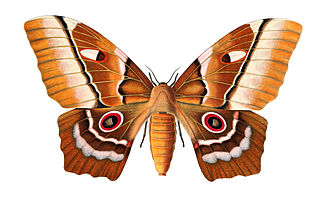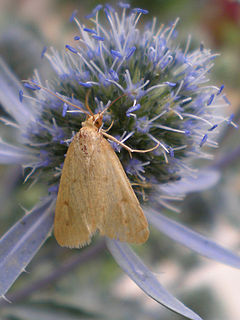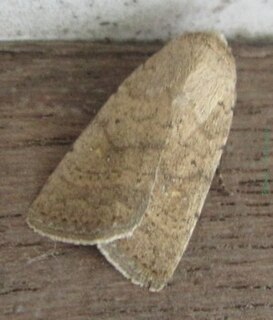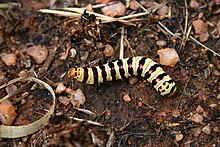Eutomis is a genus of moths in the subfamily Arctiinae. It contains the single species Eutomis minceus, which is found in South Africa.

Diaphone is a genus of moths of the family Noctuidae.
Josefrazowskia is a genus of moths of the family Tortricidae. It contains only one species, Josefrazowskia recondita, which is found in South Africa.

Lantanophaga pusillidactyla, the lantana plume moth, is a moth of the family Pterophoridae. It is native to the southern United States, Mexico, the Caribbean and South America. It was introduced to Australia accidentally in 1936 and is now found from Sydney to Cairns along the coast. It has also been introduced to Hawaii in 1902, Pohnpei in 1948 and Palau in 1960 for biological control. It has since been recorded from Yap in 1987–1988 and is now distributed on all islands of the Mariana and Caroline Islands where the host plant is found, except Aguijan.

Pseudimbrasia is a monotypic moth genus in the family Saturniidae described by Pierre Claude Rougeot in 1962. Its only species, Pseudimbrasia deyrollei, described by James Thomson in 1858, is found in the mid-latitudes of Africa.

Rohaniella pygmaea, the pigmy emperor, is a moth of the family Saturniidae. It is found in Africa, including Namibia and South Africa. The species was first described by Peter Maassen and Gustav Weymer in 1885.

Basiothia medea, the small verdant hawk, is a moth of the family Sphingidae. It is common in open habitats throughout the Ethiopian Region, including Madagascar. It is however probably absent from the equatorial forest belt, except as a vagrant. The species is an active migrant.

Coryphodema tristis, the quince borer, sad goat or apple-trunk borer, is a moth of the family Cossidae. It is found in Botswana and South Africa.
Aethalopteryx forsteri is a moth in the family Cossidae. It is found in south-western Africa, including Namibia and South Africa.
Aethalopteryx tristis is a moth in the family Cossidae. It is found in Namibia, Kenya and South Africa.

Achyra nudalis is a moth of the family Crambidae. It was described by Jacob Hübner in 1796. It is found from southern Europe east to India and Mongolia. It has also been recorded from Yemen, Niger, Saudi Arabia and South Africa.

Dolicharthria bruguieralis is a species of moth in the family Crambidae. It is found from France, Portugal, Spain, Italy, Croatia, Romania, Bulgaria, the Republic of Macedonia, Albania, Greece and Turkey, east to Japan and Taiwan. It is also found in Africa, including Morocco, Algeria and South Africa.

Athetis ignava is a moth of the family Noctuidae. It is found in Southern and Eastern Africa, including the islands of the Indian Ocean.

Earias biplaga, the spiny bollworm, is a moth in the family Nolidae. The species was first described by Francis Walker in 1866. It is found throughout subtropical Africa including Atlantic and Indian Ocean islands.
Amerila vidua is a moth of the subfamily Arctiinae. It was described by Pieter Cramer in 1780. It is found in Cameroon, Democratic Republic of the Congo, Equatorial Guinea, Ethiopia, Ghana, Guinea, Ivory Coast, Kenya, Mauritius, Nigeria, Sierra Leone and Tanzania.
Cerynea thermesialis, the hot snout, is a species of moth in the family Erebidae first described by Francis Walker in 1866. It is found throughout subtropical Africa, from Sierra Leone to Madagascar; and from Kenya to South Africa.
Condica viscosa is a moth of the family Noctuidae. It was described by Christian Friedrich Freyer in 1831. It is found from southern Europe and North Africa to Arabia and the southern parts of western Asia. The habitat consists of lowland areas near the coast, including dry slopes, road side verges, dry river beds or fallow land.
Loxostege venustalis is a moth in the family Crambidae. It was described by Stoll in 1781. It is found in Lesotho, Malawi, Mozambique, South Africa, Zambia and Zimbabwe.
Patania expictalis is a moth in the family Crambidae. It was described by Johan Christian Fabricius in 1781. It is found in the Democratic Republic of the Congo and Zambia.









